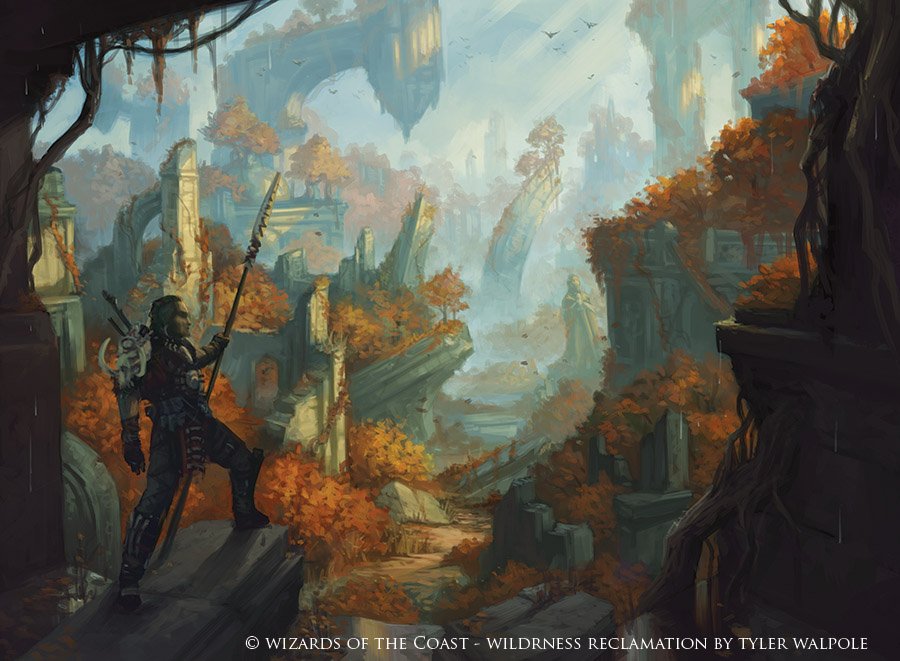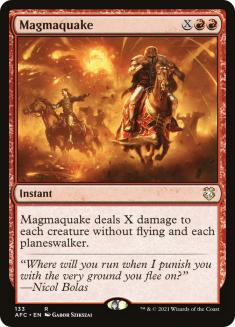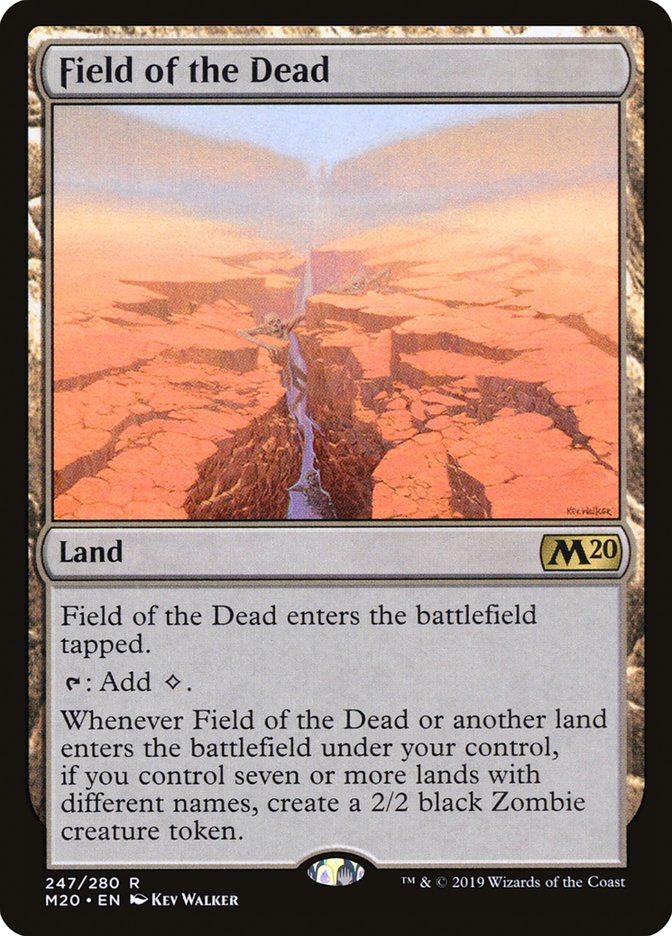The first weekend of the Players Tour Finals is in the books and we were treated to another tournament that was dominated by the Wilderness Reclamation deck and the Wilderness Reclamation deck tweaked to beat the Wilderness Reclamation deck. Yes, that sentence is supposed to make your head hurt. I’m trying to give you the authentic Standard experience.
Followers of my column should not be shocked to hear that I’m just done with Standard. The format hasn’t offered me much for a long time now, and sometimes you just need to cut your losses and walk away. Come rotation, I’m hopeful we can get back to churning metagames and interesting dark horse decks. For now, if you’re stuck playing Standard, continue to play and master Temur Reclamation. If nothing else, the deck rewards practice, and players who enjoy playing a single deck to a point of mastery might find real joy here.
I’m headed to greener pastures though. I’ve set out into the land of Historic, where an oddball collection of reprints from Magic’s past combines with an aggressive ban policy and a card pool just large enough to be varied and small enough not to be loaded with broken interactions. Truly, a space where anything should be possible.

Creatures (3)
Lands (30)
Spells (27)
- 4 Explore
- 3 Magmaquake
- 1 Search for Azcanta
- 4 Expansion
- 4 Growth Spiral
- 4 Wilderness Reclamation
- 2 Aether Gust
- 1 Mystical Dispute
- 1 Thassa's Intervention
- 3 Shark Typhoon
Sideboard

Creatures (3)
Lands (30)
Spells (27)
- 4 Explore
- 3 Magmaquake
- 1 Search for Azcanta
- 4 Expansion
- 4 Growth Spiral
- 4 Wilderness Reclamation
- 2 Aether Gust
- 1 Mystical Dispute
- 1 Thassa's Intervention
- 3 Shark Typhoon
Sideboard

Two reasonably sized Historic tournaments were run this past weekend and we’ve got detailed results thanks to our friends at MTG Melee. Both were won by Temur Reclamation. Three of the four finalists were Temur Reclamation. One tournament saw 37.5% of the metagame playing Temur Reclamation and the deck still posting a 61% win rate. The other, larger event had only 15% of the field on the deck. So the deck popped off with a 72% win rate. Temur Reclamation is the best deck in yet another format. If you’re in the mood for even more bad news, Wilderness Reclamation decks continue to pick up metagame share in Pioneer and Modern as well. The card is just broken.
In Standard, the power level and adaptable gameplans of the archetype make it hard to see any way out of the present conundrum. However, when it comes to Historic, I’m happy to report I’ve found some silver linings in the cloud that Temur Reclamation has begun to cast. I’m not saying the deck isn’t the best option right now, or that Wilderness Reclamation won’t ultimately become yet another engine added to the unending list of bans that has defined Magic in 2020. Historic’s broader card pool has left us with some tricks up our sleeves though.
To efficiently attack it, we’ve first got to identify Temur Reclamation’s strengths and weaknesses. A lot has changed for this archetype in its transition to Historic, and if you take a shortcut and treat it like the Standard deck you are going to have a bad time.
Perhaps the biggest fundamental change for the deck is a sweeper that gels with the broader gameplan. Things like Storm’s Wrath always felt awkward in Standard versions because of stunted development on a key turn. The best interactive hands for Historic Temur Reclamation will now be casting Wilderness Reclamation and sweeping your battlefield on Turn 3, and Magmaquake will continue to scale as the game goes long. Magmaquake is also an efficient out to Bant-style decks that would attempt to set up Teferi, Time Raveler and Narset, Parter of Veils to put Temur Reclamation in a prison-like lock.
Invalidating the successful mode of controlling the deck and the most efficient aggressive strategies with a single card is a big feather in the cap of this archetype. The shift of Wilderness Reclamation decks towards Magmaquake makes me wonder if we have another Hogaak, Arisen Necropolis-esque situation where the banning of a payoff card rather than the enabler – in this case, Nexus of Fate; in Modern Hogaak’s case, Bridge from Below – actually pushed people towards building Wilderness Reclamation decks in a more globally effective manner.
You know how when you play against Temur Reclamation in Standard, it always feels like your opponent has Growth Spiral on Turn 2? Now it doesn’t just feel like it. They legitimately always have it.
The certainty of them having access to four mana on Turn 3 changes how you must approach the matchup against Temur Reclamation. If you’re attempting to interact with the deck you are priced in to finding the best one- and two-mana ways to do so. If you are attempting to ignore your opponent, then you must achieve your goals by Turn 4 at the latest, but pure combo approaches need to start looking at Turn 3 as the goal and should be able to achieve wins through a swept battlefield.
Here’s the real squeeze. In Standard you can talk yourself into trying to play a long game against Temur Reclamation with something like Azorius Control. There’s enough room for expression in both deckbuilding and play skill to make the matchup palatable, if not favorable.
In Historic, Field of the Dead will kill you. Period. This deck has multiple very real gameplans and sitting back unlocks all of them. Giant uncounterable Shark. Explosion for a million as soon as you tap out. Slow, inexorable march of Zombies. Pick your poison.
These three cards mix into the already solid foundation to cement a nightmare matchup for much of the existing format, even the decks that had everyone up in arms just last week. Yes, I’m looking at you, Goblins.
Creatures (37)
- 4 Goblin Matron
- 2 Goblin Warchief
- 3 Gempalm Incinerator
- 2 Goblin Ringleader
- 4 Skirk Prospector
- 4 Goblin Chieftain
- 3 Krenko, Mob Boss
- 4 Wily Goblin
- 4 Goblin Instigator
- 4 Conspicuous Snoop
- 3 Muxus, Goblin Grandee
Lands (23)

Creatures (35)
- 2 Goblin Matron
- 4 Goblin Warchief
- 4 Skirk Prospector
- 4 Goblin Chieftain
- 4 Krenko, Mob Boss
- 4 Wily Goblin
- 4 Goblin Instigator
- 1 Goblin Cratermaker
- 4 Conspicuous Snoop
- 4 Muxus, Goblin Grandee
Lands (25)

Of these two decks, I have a strong preference for the Rakdos build. Four Muxus, Goblin Grandee strikes me as non-negotiable, and both Duress and the Goblin Chainwhirler / Call of the Death-Dweller combo out of the sideboard seem like more than enough of a reason to tax the manabase the tiniest bit.
Despite reasonable representation in both tournaments, these two twelfth-place finishes represent the best results for Goblins on the weekend. When you check out win percentages, the story gets even worse. Mono-Red Goblins and Rakdos Goblins had a combined record of 47-57 across the two tournaments for a win percentage of just 45%. Not only did Goblins have a hard time bearing the focus of the format, it’s a deck that plays right into Temur Reclamation’s hands.
Goblins does its thing on the battlefield, and its only real way to outclass Temur Reclamation is with Turn 3 or Turn 4 kills courtesy of Muxus. This is a realistic endeavor in pre-sideboard games when Temur Reclamation simply must find one of three Magmaquakes, but once Temur Reclamation unlocks the full set of Aether Gusts along side some additional spot removal and Flame Sweeps, Goblins has little chance in the matchup. In my experience, Goblin Ruinblaster has been little more than an inconvenience. The Temur Reclamation deck is just too good at finding lands and generating card advantage. Maybe Goblins can be redeemed with a Goblin Ringleader-focused build for far more staying power, but I have a hard time believing its going to be enough to overcome a brutal combination of sideboard answers.
So what does work then? Well, we don’t get easy answers here. Every single non-Temur Reclamation deck that was played across the two tournaments with reasonable representation (defined as four or more copies played) had a sub-50% win rate. We need to both rebuild existing lists and think about new ways to pressure the format. I can think of three reasonable ways we can start trying to attack Temur Reclamation.
Tempo
Temur Reclamation absent its key card is a powerful but fair deck that relies on some fairly expensive spells. Despite its discount once it enters the battlefield, the key piece, Wilderness Reclamation, is still a four-mana enchantment. Back in my day, that was the type of deck we punished with cheap threats and some countermagic.
Creatures (21)
- 4 Siren Stormtamer
- 4 Pteramander
- 4 Spectral Sailor
- 4 Brineborn Cutthroat
- 2 Brazen Borrower
- 3 Sea-Dasher Octopus
Lands (21)
Spells (18)
- 4 Lookout's Dispersal
- 4 Curious Obsession
- 2 Essence Capture
- 1 Tale's End
- 3 Mystical Dispute
- 4 Lofty Denial
Sideboard

While I love Stefan’s deck choice for this tournament, I do have some gripes with his specific build of the archetype. First, it feels like we are far to heavy on conditional countermagic. I just don’t understand Lookout’s Dispersal here, even with twelve Pirates. We have a conditional counter that will always be up to the task on Turn 2. Diversify, and get some Spell Pierces in the mix that allow you to challenge Growth Spiral and Explore.
We also need to find some options that enable us to play later turns of the Temur Reclamation matchup while still being live elsewhere. The pillars of this format, and indeed many of the options lurking in Tier 2, are extremely vulnerable to Aether Gust. Some of these sideboard copies need to move to the maindeck.
Likewise, I’m looking at including a couple of copies of Wizard’s Retort, even with a paltry number of Wizards available. Three-mana countermagic will work for a lot of our purposes and when it upgrades to a two-mana hard counterspell we can almost always engineer an upgraded line on the back of that flexibility.
Brineborn Cutthroat is doing nothing for me here. I’d rather lean harder on ways to get my Petramanders large, like Opt, and take advantage of the fact that I’ve picked up additional Curious Obsession effects and can churn through my deck. Here’s my attempt at a rebuild.
Creatures (17)
Lands (20)
Spells (23)

I’m looking at a sideboard plan that lets me trim on threats and Curiosities in favor of a Frantic Inventory plan against removal-heavy decks like Rakdos Sacrifice. I suspect it remains a nightmare matchup, but let’s get the primary problem in the format taken care of and then we can double back around to improving matchups against the decks that Temur Reclamation is oppressing.
Size
While I previously sang the praises of Magmaquake in Temur Reclamation, there’s no question that the card is being asked to carry a huge amount of the removal burden. That’s fine with the metagame being what it is, but what happens when people start choosing creatures specifically to outsize what Magmaquake is typically capable of?
Creatures (33)
- 4 Llanowar Elves
- 4 Carnage Tyrant
- 3 Rekindling Phoenix
- 4 Steel Leaf Champion
- 3 Questing Beast
- 4 Bonecrusher Giant
- 4 Ilysian Caryatid
- 2 Zilortha, Strength Incarnate
- 2 Garruk's Harbinger
- 3 Terror of the Peaks
Lands (23)
Spells (4)

I’m not sure I’ve ever seen anyone commit harder to keyword: big. Yes, that’s a Zilortha, Strength Incarnate.
I don’t really know what to make of this deck. It seems hard to succeed with big Gruul in an Aether Gust world, but there are only so many Aether Gusts an opponent can have and almost everything in this deck will kill in short order. Maybe the deck should consider its own Explores and a higher land count. 23 lands, mono-five drops is usually not a recipe for success.
I think there’s another way to do the big threat thing, and it comes with protection from Aether Gust.
Creatures (27)
- 4 Kitesail Freebooter
- 3 Vicious Conquistador
- 4 Graveyard Marshal
- 4 Spawn of Mayhem
- 4 Gutterbones
- 4 Rotting Regisaur
- 4 Knight of the Ebon Legion
Lands (24)
Spells (9)
Sideboard

I’m trying to thread a bunch of needles here with a perfect combination of clock, disruption, and sticky bodies. Does the raw size of Rotting Regisaur and Spawn of Mayhem spell trouble for Temur Reclamation? Well, certainly if Kitesail Freebooter and Drill Bit are complicating matters by grabbing key answers. Turn 2 Regisaurs are a huge draw to this deck, and maybe you’re supposed to be riskier with your Phyrexian Tower counts despite your hunger for black pips.
I don’t think it’s hard to put together a good Temur Reclamation matchup from this pile of cards; the real problem is everything else. Goblins is an utter nightmare in Game 1 and the only way it seems manageable in sideboard games is by going full control. Even still, you’re banking on the idea that this week’s results should see Goblins trending down.
Pure Goldfish
It’s time to go on a deep dive for the true Turn 3/Turn 4 combo decks in the format. If you can achieve this goal with reliability, then it’s possible you can punish Temur Reclamation’s setup turns hard enough to find success. One path that intrigues me is Song of Creation. I’m still in the sketching stage, but here’s an early take.
Creatures (20)
- 3 Ornithopter
- 4 Chamber Sentry
- 4 Emry, Lurker of the Loch
- 4 Stonecoil Serpent
- 2 Thassa's Oracle
- 3 Kinnan, Bonder Prodigy
Lands (20)
Spells (20)

Turn 1 Emry, Lurker of the Loch has me feeling things again. Does this deck have enough Turn 3s up its sleeve to overcome the fact that it is functionally reliant on a single card that gets completely hosed by both Aether Gust and Mystical Dispute? Almost certainly not. Maybe in a Best-of-One context something like this has promise. I’d normally throw away any idea with such a narrow range of applicability, but with the Day 1 of this weekend’s Arena Open being contested in the Best-of-One format, maybe a glass cannon like this actually has some value.
In the long run, we’ll have to look for a combo with a bit more resiliency if we’re going to unseat Temur Reclamation. Good news: I think one of my fellow authors here on StarCityGames.com just might be on the right path.





